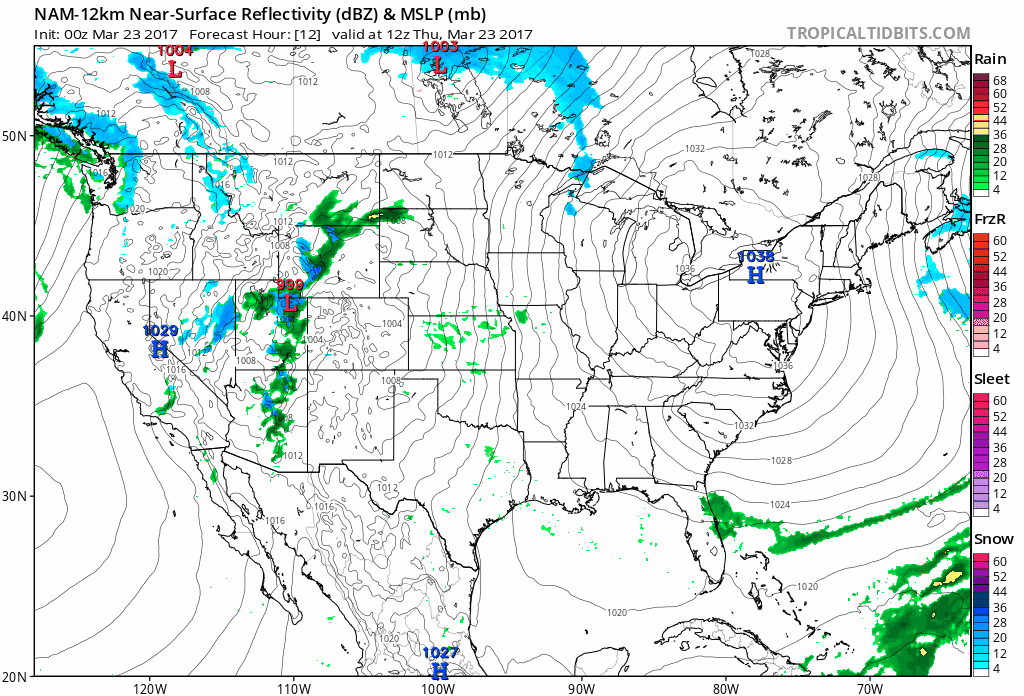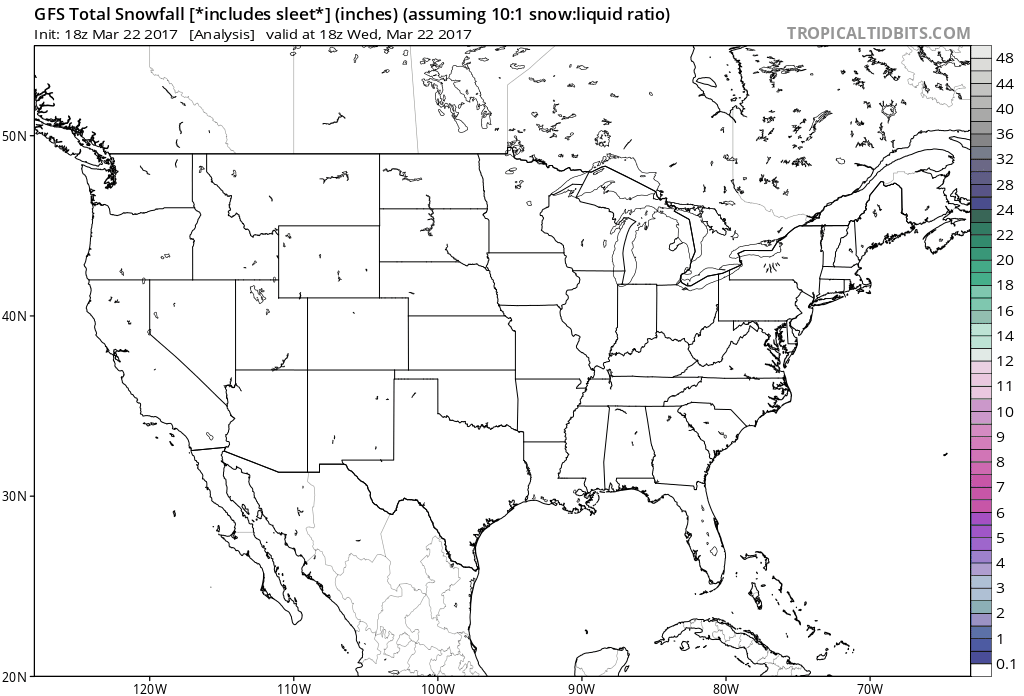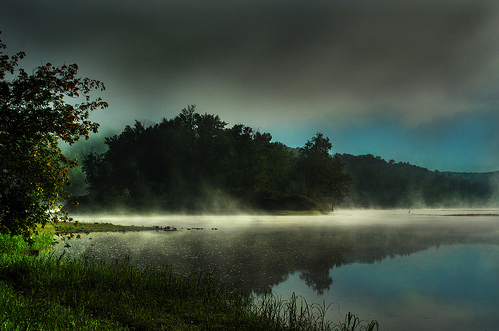44 F. average high on March 22.
55 F. high on March 22, 2016.
March 23, 1966: A snowstorm brings a foot of snow to southern Minnesota.

No Drama, Just A Few Premature April Showers
“If
we had no winter, the spring would not be so pleasant: if we did not
sometimes taste of adversity, prosperity would not be so welcome" wrote
Anne Bradstreet.
Our youngest Naval Officer son is
stationed in San Diego, the city with the best overall climate in
America. Lukewarm sunshine. Palm trees. What's not to like? "Dad, I'm
bored - every day is the same" Brett told me recently. "I miss
Minnesota's lakes and four distinct seasons" he said, much to my
surprise.
Minnesota DNR data shows a high fire risk for
the Twin Cities. Until we green up, the risk of brush fires will
persist. And latest guidance hints at an El Nino warm phase returning by
summer and fall. Based on record warm water temperatures in the Gulf of
Mexico and an active subtropical jet stream I'm predicting the most
violent spring for U.S. tornadoes since 2011. I hope I'm wrong.
After
a false start the maps look like spring again: showery rains today into
Saturday. ECMWF guidance shows highs near 50F into much of next week.
No freezes or slushy slaps for the next 2 weeks as we limp into an
uncertain spring.
Fire Risk Until Spring Green-Up.
Rain over the next 3 days will help to keep topsoil and brush damp,
reducing the fire risk slightly. But until we really green up a nagging
wildfire threat will linger. Map: MN DNR.
Springier Next Week.
It looks like 40s the next few days with (rain) showers and sprinkles -
fairly unpleasant, but hardly unusual for late March. ECMWF guidance
shows highs above 50F next week. Not time to break out the shorts, but
things should be greening up within 2 weeks or so. MSP data:
WeatherBell.

Winter Hanging On Out West - and New England.
Don't write winter off just yet. GFS 10-day snowfall totals show
impressive 1-2 foot snowfall amounts over much of northern New England
and more fresh snow for the Rockies and higher elevations of the western
USA. Spring is always two steps forward, one step back. Or is it the
other way around? GFS animation: NOAA and Tropicaltidbits.com.
Active Pattern Continues into April.
After an extended tornado drought I have a hunch 2017 will bring far
more violent storms to the USA, the result of unusually warm water in
the Gulf of Mexico and a persistent subtropical jet stream turning up
the intensity of wind shear east of the Rockies. Looking 2 weeks out the
flow is mainly zonal - no bitter slaps into the first week of April.
Another El Nino Brewing? According to NOAA NCEP ENSO-neutral may morph into another El Nino warm phase in the Pacific by late summer and autumn.
Map credit: "Sea surface temperature difference from average." (WeatherBell.com)
Most Active Start to Tornado Season Since 2008. Thanks to Johnny Kelly for passing this nugget along.
Freezing Temperatures Devastate South Carolina Farmers. More details via South Carolina Department of Agriculture: "Last
week, temperatures dipped to record lows and now South Carolina peach
farmers face the worst crop damage they have seen in ten years.
Strawberries and blueberries were among other crops damaged during the
freeze. Members of the South Carolina Peach Council and other industry
representatives met Monday morning to discuss the severity of the damage
to the peach crop, which was in early bloom due to an unseasonably warm
winter. Farmers are hopeful to have ten to fifteen percent of their
usual crop. Peach-lovers can still expect to see local peaches in July
and August in limited quantities. Statewide, strawberries have
experienced about a fifteen percent loss. Midland and Upstate blueberry
farmers are reporting significant loss, similar to that of peaches.
Information is still being gathered from blueberry farms in the lower
part of the state..."
Springtime's Cherry Blossoms Have a Dark Side.
The date of first bloom is coming consistently earlier, from Tokyo to
Washington D.C., based on meticulous record-keeping. Here's an excerpt
from TIME: "...The
following numbers are one example of cherry blossoms have reached peak
bloom earlier as temperatures have been getting warmer, courtesy of
Takehiko Mikami, a meteorology professor emeritus at Tokyo Metropolitan
University, whose calculations are based on data from Japan
Meteorological Agency.
Average March temperatures in Tokyo:1981-1990: 8.7°C [46.7°F]1991-2000: 9.4°C [48.92°F]2001-2015: 10.0°C [50°F]Average full blossoming dates of cherry trees in Tokyo:1981-1990: April 91991-2000: April 42001-2015: March 29
The
same trend has occurred in Washington, D.C., as peak bloom has shifted
early by about five days since 1921, and weather station measurements
since 1946 show a temperature increase of 1.6 degrees Celsius (2.88
degrees Fahrenheit) per century..."
Why People Think Weather Forecasts Are Bad When They Are Actually Pretty Good. Dr. Marshall Shepherd explains weather-accuracy perception vs. reality at Forbes: "...The
reality is that modern-day weather forecasts are pretty accurate so I
decided to explore reasons people think they are bad. A field goal
kicker could make every single kick during football season, but what if
he misses the "big one" in the championship bowl game? He may be
ridiculed or criticized, but is he a bad kicker? Probably not, but he
did miss a kick with great impact. Weather forecast outcomes are very
similar. The March Blizzard of 2017 happened.
It really did. However, a vigorous debate ensued on whether it was a
"bust" because it did not produce snowfall totals and blizzard
conditions in the big cities along the I-95 corridor. Some argued that forecasters adequately conveyed the uncertainty with the forecast while others suggested that
the National Weather Service made some errors in leaving Blizzard
warnings up in the big cities though models seemed to be backing off..."
Healthcast: Air Quality Impacts Exercise. Outdoor air pollution is the world's biggest killer, claiming more lives, worldwide, than malaria and HIV/AIDS. Praedictix.com meteorologist Kristin Clark reports: "Now a new study
finds that simply exercising outdoors in poor air quality can be more
detrimental to your health than not exercising at all. Researchers
reveal that in some cities air pollution levels have increased to the
point where just 30 minutes of cycling outweigh the benefits of the
exercise altogether. As a cyclist myself this is a surprising stat.
Seems counterintuitive, right? Exercise, no matter in what environment,
should be good for our body and our overall health, right? Wrong. Air
pollution is so bad in certain areas that even walking poses a serious
health threat. Granted this finding holds true for only the most polluted cities on Earth. Zabol, Iran and Gwalior, India are the top two most polluted cities in the world according to the World Health Organization (WHO). More than 80% of people living in low-income cities that monitor air pollution are exposed to air quality levels that exceed WHO limits..."
Image credit: "Scale of PM2.5 particles. The human hair is 30 times larger than fine particles." Source: EPA
As the Captain: What Happens When Lightning Strikes a Plane? An interesting response at The Detroit Free Press: "...Lightning strikes will usually leave small burn marks or holes at the entry and exit point. Airplanes are designed to allow lightning to move along the skin of the airplane without doing damage. Occasionally, a static wick will be the victim of lightning exiting the airplane. I have been in airplanes that have sustained lightning strikes several times with very little damage.... In the air, airplanes are designed to dissipate the lightning quickly. I have been flying airplanes that were struck multiple times, and there was little or no damage sustained. All the surfaces are bonded, giving the lightning a pathway to pass back into the atmosphere. On the ground, there is a risk to people on the ramp if the airplane discharges the lightning. For the passengers, there is very little or no risk in either situation..."

Why Scientists Are Worried About a Landslide No One Saw or Heard. Atlas Obscura has an intriguinig story: "If a steep mountainside in a remote national park gives way and drops 200 million tons of rock into deep glacial water, will anyone hear? In the case of the massive landslide that fell into Taan Fjord,
Alaska, the answer was no—and yes. No one heard the mountainside fall
into the fjord on a rainy night on October 17, 2015. No one saw an
almost unimaginably huge and powerful wave crest at 600 feet and sweep
down the inlet. The tsunami obliterated forests on both sides of the
inlet, and its rush to the sea dragged an iceberg over a marine spit and
out into coastal Icy Bay. The enormous wave, an estimated 60 feet high
in the middle of the inlet, traveled eight miles to open water and made
it all the way to about five miles north of Icy Bay Lodge..."
Photo credit: "The giant scar of the landslide is put into perspective by the skiff surveying the damage." Photo by Bjørn Olson, Courtesy of Ground Truth Trekking
Analysis: Electric Vehicles Pay Their Fair Share in State Taxes. Here's an excerpt of a story at Great Plains Institute that caught my eye: "Recent
tax policy analysis by the Great Plains Institute (GPI) for Drive
Electric Minnesota found that electric cars pay just as much or more
taxes as comparable gasoline vehicles. Like most other states, Minnesota
uses a tax on the sale of gasoline and other motor fuel to pay for
transportation infrastructure like highways and bridges, among other
uses. This excise tax is paid by the consumer at the pump at a rate of
28.5 cents per gallon ($0.285 / gal), which means that the more one
drives, the more taxes one will pay through the consumption of
additional fuel. Since more driving causes more wear and damage to
public driving infrastructure, this makes sense. This also means,
however, that plug-in electric vehicles (EVs) do not pay any motor fuel
excise tax..."
Image credit: "In the next decade, the energy storage industry will go from the familiar, like the iPhone, into much bigger applications like electric cars and the power grid." Photos courtesy of the Pacific Northwest National Laboratory, Pixabay, Dave Dugdale/Flickr (Tesla).
Image credit: BBC

Job-Stealing Robots? Millennials See Hope, Fear in Automation. Every threat is an opportunity, right? Here's a clip from LinkedIn: "...Dramatic shifts in the how and the where of the future of work recently prompted my 15-year-old to ask, “Mom, are robots going to take my job someday?” Timely question. Deloitte Global’s latest survey of millennials shows many are asking the same thing. While they recognize the benefits of automation in terms of productivity and economic growth, they also see it providing opportunities for value-added or creative activities, or learning new skills:
- 40 percent see automation posing a threat to their jobs;
- 44 percent believe there will be less demand for their skills;
- 51 percent believe they will have to retrain; and
- 53 percent see the workplace becoming more impersonal and less human. Which is news that should make every CEO sit up and take notice, given this generation’s use of social media..."
TODAY: Few rain showers - damp. Winds: SE 10-15. High: 43
THURSDAY NIGHT: More showers. Low: 40
FRIDAY: Milder with showery rains, heaviest over southern Minnesota. Winds: NE 8-13. High: 49
SATURDAY: Early showers, then slow clearing. Wake-up: 38. High: near 50
SUNDAY: Mostly cloudy, cool breeze. Winds: N 5-10. Wake-up: 37. High: 49
MONDAY: Still gray, cool and damp. Winds: N 7-12. Wake-up: 39. High: 48
TUESDAY: Partly sunny and milder. Winds: E 5-10. Wake-up: 36. High: 56
WEDNESDAY: Fading sunshine, stronger winds. Winds: E 10-20. Wake-up: 38. High: 57
Climate Stories...
* The 28 page WMO (World Meteorological Organization) report on the climate is here.
More Extreme Weather Coming After Record 2016 Heat, WMO Says. Bloomberg provides more perspective on the WMO report: "Unusually warm weather in the Arctic is helping shift weather patterns this year from North America to the Middle East, after global warming shattered records in 2016, according to the World Meteorological Organization. Rising ocean temperatures that are melting polar ice sheets, killing marine life and flooding coastal communities may have increased more than previously reported last year, the WMO said in a report Tuesday. Average sea-surface temperatures hit their highest levels ever last year, and overall temperatures over sea and land were 1.1 degrees Celsius above the pre-industrial period. At least three times this winter, the Arctic has experienced the polar equivalent of a heat wave with Atlantic storms driving warm, moist air..." (Map credit: NOAA NCDC).
The Seasons Aren't What They Used To Be. Here's an excerpt of a poignant piece at The New York Times: "...Spring has been particularly hasty and irregular this year, but this is no anomaly. In the latter half of the 20th century, the spring emergence of leaves, frogs, birds and flowers advanced in the Northern Hemisphere by 2.8 days per decade. I'm nearly 50, so springtime has moved, on average, a full two weeks sinnce I was born. And you? We now experience climate change not only through the abstraction of science, but also through lived experience..." (Image credit: NOAA).
Photo credit: "Rep. Carlos Curbelo, R-Fla., speaks to reporters at the Capitol about climate change on Monday, March 20, 2017. He is flanked by Republican Reps. Mark Sanford of South Carolina (from left), Brian Mast and Ileana Ros-Lehtinen of Florida and Ryan Costello of Pennsylvania." Curtis Tate McClatchy
Climate Change is Certainly Causing More Powerful Storms. Here's a clip from an article at Salon: "...The ‘100-year flood’ now occurs more often than once a century,” Hansen said. Michael E. Mann, Director of the Earth System Science Center and Distinguished Professor of Meteorology at Penn State University, observed that the warming climate is actually causing more snow. “The oceans have been at record levels of warm the past two years (and climate change is a key contributor to that),” Mann said. “That record warmth means that there is more moisture in the atmosphere that is available both to help strengthen the storm and produce record snowfalls as the warm oceanic air is entrained in toward the eastern U.S. by the cyclonic winds of the storm. Climate model simulations indicate a likelihood for stronger, more snow-making storms, and that’s what we’re seeing...”
Superstorm Sandy file imagery: Mel Shapiro, NCAR.
Here's How Climate Change is Already Affecting Your Health, Based on the State You Live In. Yahoo News has the story: "Climate change is already beginning to wreak havoc upon the planet. In the short term, we're facing more winter storms, miserably hot summers, and a longer allergy season. In the long term, entire coastlines will likely disappear, threatening communities and wildlife. On a more local level, experts say the US will be unrecognizable in 100 years. But just how is all of this affecting you — your state, your coastline — right now? A new report from the Medical Society Consortium on Climate and Health reveals
that different geographic regions in the US are facing a range of
effects, many of which are already taking shape today. Some of them are
as geographically specific as to affect only one state..."
No comments:
Post a Comment